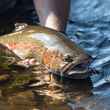What makes a new rod a company’s biggest release ever? Or most important? Or even most noteworthy? It’s hard to imagine any objective measure. That said, it may be equally hard to imagine that when Sage introduced the X back in June, the Bainbridge Island rod maker hadn’t reached its biggest milestone to date.
As the 10th flagship fly rod for Sage, the X marks the culmination of over 35 years of not just experience, but experience amongst the industry leaders in rod making. Sage’s chief rod designer, Jerry Siem, and before him the renowned Don Green, have spent the better part of those four decades designing some of the finest fishing tools the industry has ever seen.
Sage rods of yesteryear like the RPL and XP have cult-like followings. For many anglers, they were the it rod. But why? If you think that it is because the RPL and XP were inherently better rods than those that came before or after them, you’re wrong. Despite what anyone tells you, rods aren’t good or bad all by themselves, rods are good or bad for individual anglers. And, over the years, that’s what Siem and Green and Sage have been so good at: making rods that turned out to be the it rod for more anglers than anyone else. For me, that rod was Sage’s Z-Axis, another one of Sage’s cult-like followings and a rod that has served as my personal yardstick by which I’ve measured all other rods (well, trout rods at least) since I first cast one.
Each of those rods was borne of Sage’s consistent devotion to developing not just new rod designs but new materials from which to build them. Sage’s close ties to nearby Seattle-based Boeing affords the company unique access to cutting-edge advancements in materials, giving Sage’s engineers the opportunity to spend their days in a very sciencey looking lab tinkering with new graphites and resins and testing their creations on Instron machines and the casting pond behind the factory.
The latest material to come out of that lab, Sage’s new KonneticHD, is the backbone and foundation of the X. Though many, even likely Sage themselves, will describe KonnecticHD as an evolution of its Konnetic material, to me, KonneticHD is something altogether new that has allowed Sage to build a one-of-a-kind rod that, in what ways it bears resemblance to other Sage rods, is more reminiscent of some of its most beloved creations rather than an iterative improvement on its last generation of rods.
What Works
Better the second time around
As noted, KonneticHD is Sage’s latest iteration of its Konnetic material. While the original Konnectic offered up some important technical advancements, the fruit it bore weren’t always right for me. Konnetic felt at home on the flats, but not so much the trout rivers I fish. One of my favorite Konnetic rods is Sage’s ultra-fast METHOD which, oddly enough, I find myself more able to dig into the mid and butt sections of than other Konnetic rods. Plus it throws darts on the flats. And I like the SALT well enough, especially the fact that it is much more supple than its predecessor the Xi3 while still having a crisp tip. But I’ve never managed to find much love for the most well known of the Konnetic rods and Sage’s last flagship rod, the ONE. The fact that I haven’t has earned me more than my fair share of bewildered glances, but the truth is I’ve often found the ONE lacking personality, lacking that it factor that led to my romance with my Z-Axis.
KonneticHD is, despite the implication above, an evolution of Konnetic. You can, and should, read more about that evolution, about Sage’s improvements over Konnetic through the use of proprietary graphite/resin composites, resulting in a denser material, better fiber alignment, more efficient energy transfer and so on.
But, what’s most important is that, in my opinion, those improvements created a material that tows along and improves upon the technical advancements of Konnetic—thinner, lighter, greater torsional stability—but also one that has a great deal more versatility and character than its predecessor. The X throws darts just like the ONE and METHOD do, but it’s a hell of a lot more fun to cast.
Fast that bends
For many years, fast rod manufacturers gave fast rods a bad name. They did this by making rods that didn’t bend. Alright, that’s overstating things a bit. They did bend, but not nearly where or how you’d want them to. Virtually every major rod maker, Sage included, was guilty of this. Thankfully, that trend is reversing and most brands are building rods that attempt to offer the best of both worlds—fast rods that bend.
Sage’s new X may be the best example of that trend thus far.
Reminiscent of Z
The Z-Axis’ had a crisp, powerful action that was, at the same time, lively and responsive. And it was, and is, a distinct pleasure to cast. If you're waxing poetic, you might say it was somewhat enchanting. Even novice casters would commonly pick up the Z-Axis and find an immediate appreciation of its smooth, efficient character.
In the X, Sage seems to have struck this same chord again, but perhaps even more impressively. Casting the X is evocative of all of the things I’ve loved for so many years about my Z-Axis, yet it manages to give me more in virtually every area of my fishing.
Extremely versatile
I always touted my Z-Axis for its versatility, but after a few months of fishing the X, it’s sad to say that beloved rod is feeling a bit limited in comparison.
The X has proven to be the best fast-action dry fly rod I've fished in memory (it's worth noting that this is typically a domain where fast-action rods disappoint). Its sensitive but lively tip allows me to deliver small dries with delicacy and protect the light tippets I fish them with.
Because the X bends deep down into the blank, it also makes a hell of a streamer rod. Unlike some anglers, who (counter-intuitively, in my opinion) seem to head out to fish streamers with as stiff a rod as possible, I prefer a moderately-fast rod for streamer fishing. Something with power and punch, but with enough bend to allow me to work streamers both short and long and allow me to slow down my casting stroke to manage heavy flies and sink tips with at least some small measure of grace. I’ve put the X from a 5 to a 7 through streamer duty and it has consistently surprised with its ability to skillfully deliver whatever I’ve asked of it, whether that be profanely weighted dolly llamas or bulky 6” streamers tied to sink tips.
Over the years, I've found the needs of nymphing to merit a unique tool more so than any other aspect of my fishing. I can throw a dry fly with a 2x4 if hard-pressed and I can throw a streamer with an overcooked spaghetti noodle if I'm forced to, but managing a double or triple rig of heavy nymphs on a rod that isn't up to the task can quickly develop into a nightmare that you can't be roused from. The X isn't a nymphing rod. It's not a 10 or 11 foot moderate to moderate-fast action rod that's going to have you joyfully flipping and roll casting nymphs all day (for that, look at Sage's ESN, the only other rod currently in Sage's lineup built on a KonneticHD backbone). But, as far as nymphing duty goes, it's at the front of the pack of all-around rods. Thanks presumably to the improved energy transfer in KonneticHD that Sage is touting so highly and to the fact that you can access more of the blank, the X is an excellent roll caster, even when you load it up with a couple of heavy stoneflies.
Accuracy Abounds
Over the years, my fishing has evolved into a more methodical affair. Most commonly, I’ll survey a given run or riffle, or other piece of water, devise a game plan, and set to work, doing my best to surgically pick apart the water.
Rod makers love to market their rods with claims of accuracy, but those claims are often to be taken with a grain of salt. The X, however, is simply one of the most accurate rods I’ve cast. More importantly, the X offers up accuracy without feeling restrained. There’s very little wiggle when stopping the rod or driving a cast. And, provided you haven’t done something to bugger your cast, you’re likely to find yourself surprised by how effortlessly you’ll be able hit your spots.
This summer, an hour spent plying a relatively small, seemingly endless, side channel of Kamchatka’s Savan River with the X—skillfully tossing mouse patterns and bulky streamers into small mid-channel buckets and pockets along the banks or bouncing them underneath tree limbs tightly overhanging the water by only a few inches, plucking fat rainbows from the water all along the way—was some of the most fun I’ve had with a fly rod in my entire life.
What Doesn’t
There’s really nothing to say here. That’s mostly because fly rod evaluations are entirely subjective and the X is a rod that does it for me. I suppose if you’re a lover of all things fast— looking for the next, even faster, potentially blunt instrument—then the X won’t be for you. Oh, and it's $895, but you already knew that.
Final Word
Whether the X is Sage's best rod or the best rod of the year or the best all-around rod is unanswerable and any claims to the contrary should be disregarded. What does it for me might not do it for you. How I fish might not be how you fish.
What is safe to say, however, is that the X is a rod that builds on some of Sage’s most important technical advancements of the last decade while offering up loads of feel and character instead of feeling blunt or limited. It's a rod that does everything I ask of it and more, one that I truly enjoy fishing and one that I find myself reaching for over and over again. Like some of Sage's most memorable successes, it's also likely to be one of those rods that both experienced and inexperienced anglers will pick up and find themselves immediately enchanted by that thing, that it factor.
It seems inevitable that Sage has its new classic on its hands, its latest rod that, years after Sage has moved on, will continue to have a cult of dedicated followers.






























Comments
Richard Swayne replied on Permalink
I currently have a 8wt and 9wt sage salt which I use for bone fishing, jacks and reds. How would you compare the sage X to the salt for fishing flats and especially windy conditions? Also how does it compare to the Scott Meridian? Thank you.
Bob replied on Permalink
I had a chance to fish the new Sage X in a 5 wt. 9 ft. the end of this September on the Bitterroot river in Montana. We fished drys, dry/droppers, and nymphs under indicators.
The day before I used the new X, I fished my 905 Radian and that was what I wanted to compare the new X to. I am a huge Radian fan. Fast with feel is for real with this rod.
Overall, the X is Sage's answer to the widely popular Radian. The tip of the X is certainly more compliant that the "One". Much more communicative with plenty of reserve power in the lower sections of the rod. I was surprised at how easily the rod mended line. A flick of the wrist and you had a very nice upstream mend. If I was buying a Sage rod, I would certainly give the X some test casts.
Negatives: When casting to the banks with dry/droppers, it seemed that when I needed to add an extra two feet to the cast (in the 40-50 range) the tip collapsed and the cast fell short again. I did not notice this with the Radian. The Scott rod just fired that extra two feet I needed. The Radian seemed to have that extra reserve that the X lacked.
For the price, the real seat hardware and spacer don't reflect the quality that I expected. Very plain and ordinary. For that kind of money, look at a Winston, they know how to appoint that end of the rod.
Overall, I liked the rod and would recommend it to anyone. Sage has a winner with this new rod.
sweetandsalt replied on Permalink
This positive review has passion and is well thought out and I concur the enhanced fiber compression matrix of Sage's newest rod is impressive and a contributor to the X's characteristics, particularly its excellent recovery rate relative to its deeper flex profile. I have a fundamentally different view of rod design though in that I DO believe in objective evaluation. OK, good casters are going to disagree and have preferences for one kind of action or another and this is as it should be but a rod has intrinsic properties that are perceivable and applicable whether you personally elect to adapt to them or not. The reviewer finds some commonality between X and wonderful Z-Axis; I too was a Z fan, until ONE came along which, unlike the reviewer, I find full of lively personality and enormous capability far beyond Z, but find them highly dissimilar. Z was fast morphing into a compliant tip with a smooth transition, a little like current Scott Radian while X has a taper much more like ONE but flexing lower into the blank. It nonetheless achieves ONE like quick recovery and I concur, this has a lot to do with the stronger construction yet lower mass of the new HD material. 8 1/2'/#5 X weighs a tiny fraction less than my 8 1/2'/#4 ONE!
The greatest in its day but relatively clunky by contemporary standards, RPL begat SP(+) then XP, Sages biggest seller ever in its day and very GLX like, which Z-Axis was a big sophisticated step beyond. Controversial ONE really fulfilled the dream of a super low mass yet adaqitly durable very high line speed, technical presentation rod hinted at by some earlier more fragile and less evolved experiments and remains a unique plateau in rod design achievement.
Now more accessible X will, for some, eclipse or be an improvement upon ONE. Thus far, and this is not my last word on the subject as there are plenty of X models I have not cast and I intend to have lots of growing X experience in the coming season(s) ahead, I perceive as a complimentary, supplementary brilliant addition to my existing contemporary Sage quiver. I am tentatively inclined to group Method, ONE and now X together as a related cadre of common design concept varying in depth of flexural profile to be selected amongst based on habitat and technique applicability. Thank you, Sage.
Pages